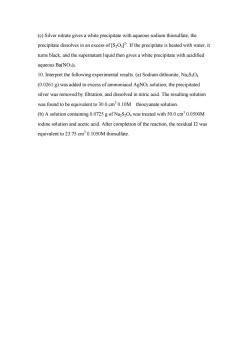北京化工大学:《无机化学》课程电子教案(试卷习题)第十三-十四章综合自我练习题及答案

Chapters 13-14 The p-block elements(II) 1.Give a briefaccount of allotropy among the group 15 elements. 2.Write equations for the reactions of(a)water with CasP2,(b)aqueous NaOH with NHCl:(c)aqueous NH;with Mg(NO3)2:(d)AsH with an excess of I2 in neutral aqueous solution,(e)PH3 with KNH2 in liquid NH3. 3.Explain why (a)a dilute aqueous solution of NH,smells of the gas whereas dilute HCl does not retain the acrid odour of gaseous HCl,and(b)ammonium carbamate is used in smelling salts. 4.(a)Write a balanced equation for the preparation of NaN3 from NaNH2 with NaNO3.(b)Suggest a route for preparing the precursor NaNH2.(c)How might NaN3 react with Pb(NO3)in aqueous solution? 5.Deduce what you can about the nature of the following reactions. (a)One mole of NH2OH reacts with two moles of Ti(IIl)in the presence of excess alkali,and the Ti(III)is converted to Ti(IV). (b)When AgzHPO3 is warmed in water,all the silver is precipitated as metal (c)When one mole of HPO2 is treated with excess I2 in acidic solution,one mole of I2 is reduced;on making the solution alkaline,a second mole of I is consumed. 6.(a)Write down,in order,the names and symbols ofthe elements in group 16 check your answer by reference to the first page of this chapter.(b)Give a general notation showing the ground state electronic configuration of each elemen 7.Hydrogen peroxide oxidizes Mn(OH)toMnO.(a)Write an equation for this reaction.(b)What secondary reaction will occur? 15.8 Predict the structures of(a)H2Se.(b)[H3S]':(c)SOz:(d)SF.(e)SF.(f)SaF2. 8.(a)Explain why the reaction of SFwith BF3 yields [SF3,whereas the reaction with CsF gives Cs[SF (b)Suggest how SFmight react with a carboxylic acid, RCO2H. 9.Discuss the interpretation of each of the following observations. (a)When metallic Cu is heated with concentrated H2SO,in addition to CuSO and SO2,some Cus is formed (b)The [TeFsion is square pyramidal
Chapters 13-14 The p-block elements( ) Ⅱ 1. Give a brief account of allotropy among the group 15 elements. 2. Write equations for the reactions of (a) water with Ca3P2; (b) aqueous NaOH with NH4Cl; (c) aqueous NH3 with Mg(NO3)2; (d) AsH3 with an excess of I2 in neutral aqueous solution; (e) PH3 with KNH2 in liquid NH3. 3. Explain why (a) a dilute aqueous solution of NH3 smells of the gas whereas dilute HCl does not retain the acrid odour of gaseous HCl, and (b) ammonium carbamate is used in smelling salts. 4. (a) Write a balanced equation for the preparation of NaN3 from NaNH2 with NaNO3. (b) Suggest a route for preparing the precursor NaNH2. (c) How might NaN3 react with Pb(NO3) in aqueous solution? 5. Deduce what you can about the nature of the following reactions. (a) One mole of NH2OH reacts with two moles of Ti(III) in the presence of excess alkali, and the Ti(III) is converted to Ti(IV). (b) When Ag2HPO3 is warmed in water, all the silver is precipitated as metal. (c) When one mole of H3PO2 is treated with excess I2 in acidic solution, one mole of I2 is reduced; on making the solution alkaline, a second mole of I2 is consumed. 6. (a) Write down, in order, the names and symbols of the elements in group 16; check your answer by reference to the first page of this chapter. (b) Give a general notation showing the ground state electronic configuration of each elemen 7. Hydrogen peroxide oxidizes Mn(OH)2 toMnO2. (a) Write an equation for this reaction. (b) What secondary reaction will occur? 15.8 Predict the structures of (a) H2Se; (b) [H3S]+ ; (c) SO2; (d) SF4; (e) SF6; (f) S2F2. 8. (a) Explain why the reaction of SF4 with BF3 yields [SF3] + , whereas the reaction with CsF gives Cs[SF5] (b) Suggest how SF4 might react with a carboxylic acid, RCO2H. 9. Discuss the interpretation of each of the following observations. (a) When metallic Cu is heated with concentrated H2SO4, in addition to CuSO4 and SO2, some CuS is formed. (b) The [TeF5] - ion is square pyramidal

(c)Silver nitrate gives a white precipitate with aqueous sodium thiosulfate;the precipitate dissolves in an excess of [OIf the precipitate is heated with water,it tums black,and the superatant liquid then givesa white precipitate with acidified aqueous Ba(NO3)2. 10.Interpret the following experimental results.(a)Sodium dithionite,Na (0.0261 g)was added to excess of ammoniacal AgNO;solution;the precipitated silver was removed by filtration,and dissolved in nitric acid.The resulting solution was found to be equivalent to 30.0cm0.10M thiocyanate solution (b)A solution containing 0.0725g of Na2S2O was treated with 50.0cm0.0500M iodine solution and acetic acid.After completion of the reaction,the residual 12 was equivalent to 23.75 cm0.1050M thiosulfate
(c) Silver nitrate gives a white precipitate with aqueous sodium thiosulfate; the precipitate dissolves in an excess of [S2O3] 2-. If the precipitate is heated with water, it turns black, and the supernatant liquid then gives a white precipitate with acidified aqueous Ba(NO3)2. 10. Interpret the following experimental results. (a) Sodium dithionite, Na2S2O4 (0.0261 g) was added to excess of ammoniacal AgNO3 solution; the precipitated silver was removed by filtration, and dissolved in nitric acid. The resulting solution was found to be equivalent to 30.0 cm3 0.10M thiocyanate solution. (b) A solution containing 0.0725 g of Na2S2O4 was treated with 50.0 cm3 0.0500M iodine solution and acetic acid. After completion of the reaction, the residual I2 was equivalent to 23.75 cm3 0.1050M thiosulfate
按次数下载不扣除下载券;
注册用户24小时内重复下载只扣除一次;
顺序:VIP每日次数-->可用次数-->下载券;
- 北京化工大学:《无机化学》课程电子教案(试卷习题)第十四章自我练习题及答案.pdf
- 北京化工大学:《无机化学》课程电子教案(试卷习题)第十二章自我练习题及答案.pdf
- 北京化工大学:《无机化学》课程电子教案(试卷习题)第十三章自我练习题及答案.pdf
- 北京化工大学:《无机化学》课程电子教案(试卷习题)第十章自我练习题及答案.pdf
- 北京化工大学:《无机化学》课程电子教案(试卷习题)第十一章自我练习题及答案.pdf
- 北京化工大学:《无机化学》课程电子教案(试卷习题)第八章自我练习题及答案.pdf
- 北京化工大学:《无机化学》课程电子教案(试卷习题)第九章自我练习题及答案.pdf
- 北京化工大学:《无机化学》课程电子教案(试卷习题)第七章自我练习题及答案.pdf
- 北京化工大学:《无机化学》课程电子教案(试卷习题)第四章自我练习题及答案.pdf
- 北京化工大学:《无机化学》课程电子教案(试卷习题)第六章自我练习题及答案.pdf
- 北京化工大学:《无机化学》课程电子教案(试卷习题)第五章自我练习题及答案.pdf
- 北京化工大学:《无机化学》课程电子教案(试卷习题)第二章自我练习题及答案.pdf
- 北京化工大学:《无机化学》课程电子教案(试卷习题)第三章自我练习题及答案.pdf
- 北京化工大学:《无机化学》课程电子教案(试卷习题)作业习题(中英文)安排及部分答案.pdf
- 北京化工大学:《无机化学》课程电子教案(试卷习题)自测题及答案-9.pdf
- 北京化工大学:《无机化学》课程电子教案(试卷习题)自测题及答案-8.pdf
- 北京化工大学:《无机化学》课程电子教案(试卷习题)自测题及答案-10.pdf
- 北京化工大学:《无机化学》课程电子教案(试卷习题)自测题及答案-7.pdf
- 北京化工大学:《无机化学》课程电子教案(试卷习题)自测题及答案-6.pdf
- 北京化工大学:《无机化学》课程电子教案(试卷习题)自测题及答案-5.pdf
- 北京化工大学:《无机化学》课程电子教案(试卷习题)第十五章自我练习题及答案.pdf
- 北京化工大学:《无机化学》课程电子教案(试卷习题)第十七章自我练习题及答案.pdf
- 北京化工大学:《无机化学》课程电子教案(试卷习题)第十六章自我练习题及答案.pdf
- 北京化工大学:《无机化学》课程电子教案(试卷习题)第十六-十七综合自我练习题及答案.pdf
- 北京化工大学:《无机化学》课程电子教案(教学课件,2011)Chapter 01 前言 Preface(负责人:周云山).pdf
- 北京化工大学:《无机化学》课程电子教案(教学课件,2011)Chapter 02 Thermochemistry.pdf
- 北京化工大学:《无机化学》课程电子教案(教学课件,2011)Chapter 03 Chemical kinetics.pdf
- 北京化工大学:《无机化学》课程电子教案(教学课件,2011)Chapter 05 Acid-Base Equilibrium.pdf
- 北京化工大学:《无机化学》课程电子教案(教学课件,2011)Chapter 04 Chemical equilibria, entropy and Gibbs function.pdf
- 北京化工大学:《无机化学》课程电子教案(教学课件,2011)Chapter 10 Solid Structure.pdf
- 北京化工大学:《无机化学》课程电子教案(教学课件,2011)Chapter 11 Coordination Compound Structures.pdf
- 北京化工大学:《无机化学》课程电子教案(教学课件,2011)Chapter 12 The s-Block Elements.pdf
- 北京化工大学:《无机化学》课程电子教案(教学课件,2011)Chapter 06 Precipitation-Solubility Equilibria.pdf
- 北京化工大学:《无机化学》课程电子教案(教学课件,2011)Chapter 08 Atomic Structure.pdf
- 北京化工大学:《无机化学》课程电子教案(教学课件,2011)Chapter 13 The p-block elements(Ⅰ).pdf
- 北京化工大学:《无机化学》课程电子教案(教学课件,2011)Chapter 07 Redox Reactions and Base of Electrochemistry.pdf
- 北京化工大学:《无机化学》课程电子教案(教学课件,2011)Chapter 09 Molecular Structure.pdf
- 北京化工大学:《无机化学》课程电子教案(教学课件,2011)Chapter 17 The d-block elements(Ⅱ).pdf
- 北京化工大学:《无机化学》课程电子教案(教学课件,2011)Chapter 14 p-block elements(Ⅱ).pdf
- 北京化工大学:《无机化学》课程电子教案(教学课件,2011)Chapter 15 p-block elements(Ⅲ).pdf
